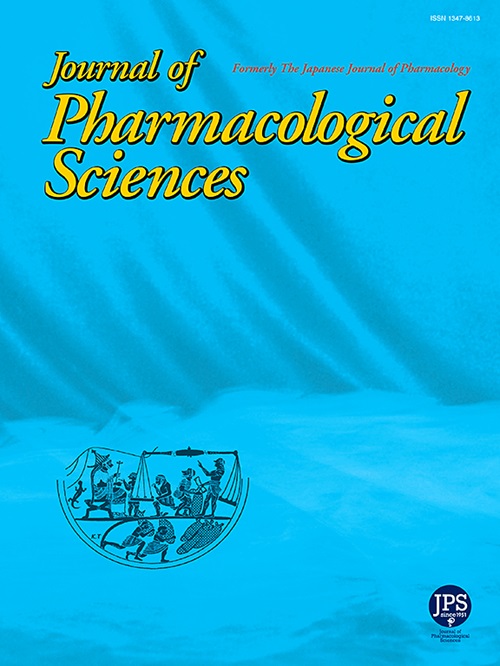Receptor-mediated Gi-3 activation in mammalian and human brain membranes: Reestablishment method and its application to nociceptin/orphanin FQ opioid peptide (NOP) receptor/Gi-3 interaction
IF 2.9
3区 医学
Q2 PHARMACOLOGY & PHARMACY
引用次数: 0
Abstract
Functional activation of heterotrimeric guanine nucleotide-binding proteins (G-proteins) via G-protein-coupled receptors (GPCRs) has been extensively explored using guanosine-5′-O-(3-[35S]thio)triphosphate ([35S]GTPγS) binding assay. However, the conventional method is primarily applicable to Gi/o family without discrimination among G-protein subtypes. Therefore, this study aims to reestablish a novel method termed “[35S]GTPγS binding/immunoprecipitation assay” by identifying a most suitable anti-Gαi-3 antibody instead of the previously utilized, now withdrawn antibody. In the initial screening of commercially available anti-Gαi-3 antibodies, two were identified and one was selected for further investigations based on efficacy with adenosine—the most potent agonist in our previous research. After optimizing experimental conditions with rat and postmortem human brain membranes, the stimulatory effects of various agonists were evaluated. Some agonists, including nociceptin, exhibited sufficient stimulatory effects for further pharmacological characterization. Nociceptin increased [35S]GTPγS binding to Gαi-3 in a concentration-dependent manner, response that was insensitive to naloxone but potently inhibited using (±)-J-113397. The method described in this study provides a valuable strategy for determining the intrinsic efficacy of ligands at various GPCRs. This includes nociceptin/orphanin FQ opioid peptide (NOP) receptor selectively coupled to Gαi-3, providing insights into the pharmacological concept of “functional selectivity.”
受体介导的Gi-3在哺乳动物和人类脑膜中的激活:重建方法及其在伤害肽/孤儿蛋白FQ阿片肽(NOP)受体/Gi-3相互作用中的应用
利用鸟苷-5′- o -(3-[35S]硫代)三磷酸([35S]GTPγS)结合实验,广泛探讨了异三聚体鸟嘌呤核苷酸结合蛋白(g蛋白)通过g蛋白偶联受体(gpcr)的功能激活。而传统方法主要适用于Gi/o家族,对g蛋白亚型没有区别。因此,本研究旨在通过鉴定一种最合适的抗g αi-3抗体来替代先前使用的现已退出的抗体,从而重建一种称为“[35S]GTPγS结合/免疫沉淀法”的新方法。在对市售抗g αi-3抗体的初步筛选中,确定了两种抗体,并根据与腺苷(我们之前研究中最有效的激动剂)的疗效选择了一种抗体进行进一步研究。在优化大鼠和人死后脑膜的实验条件后,评估了各种激动剂的刺激作用。一些激动剂,包括诺西西汀,表现出足够的刺激作用,可以进一步进行药理学表征。Nociceptin以浓度依赖的方式增加[35S]GTPγS与Gαi-3的结合,该反应对纳洛酮不敏感,但(±)-J-113397有效抑制。本研究中描述的方法为确定各种gpcr配体的内在功效提供了有价值的策略。这包括痛觉肽/孤啡肽FQ阿片肽(NOP)受体选择性偶联Gαi-3,为“功能选择性”的药理学概念提供见解。
本文章由计算机程序翻译,如有差异,请以英文原文为准。
求助全文
约1分钟内获得全文
求助全文
来源期刊
CiteScore
6.20
自引率
2.90%
发文量
104
审稿时长
31 days
期刊介绍:
Journal of Pharmacological Sciences (JPS) is an international open access journal intended for the advancement of pharmacological sciences in the world. The Journal welcomes submissions in all fields of experimental and clinical pharmacology, including neuroscience, and biochemical, cellular, and molecular pharmacology for publication as Reviews, Full Papers or Short Communications. Short Communications are short research article intended to provide novel and exciting pharmacological findings. Manuscripts concerning descriptive case reports, pharmacokinetic and pharmacodynamic studies without pharmacological mechanism and dose-response determinations are not acceptable and will be rejected without peer review. The ethnopharmacological studies are also out of the scope of this journal. Furthermore, JPS does not publish work on the actions of biological extracts unknown chemical composition.

 求助内容:
求助内容: 应助结果提醒方式:
应助结果提醒方式:


